一、案例背景
随着互联网应用的日益普及,网络贷款已成为一种常见的贷款形式。但是,网络借贷行业也存在着很多的风险失控问题。为了规范网络借贷过程管理,加强网络借贷风险控制,业界人士开始采用一些技术手段来规避网络借贷风险。
许多金融服务机构在前期的业务运营中积累了大量的客户数据,如个人基本信息、在机构办理业务信息等数据。本文正是基于数据挖掘技术,综合客户各项信息数据及以往业务中是否违约为分类标签,进行模型训练,经过调整优化后对新的申请用户信息进行分类预测,以预测结果作为核发贷款的重要依据。
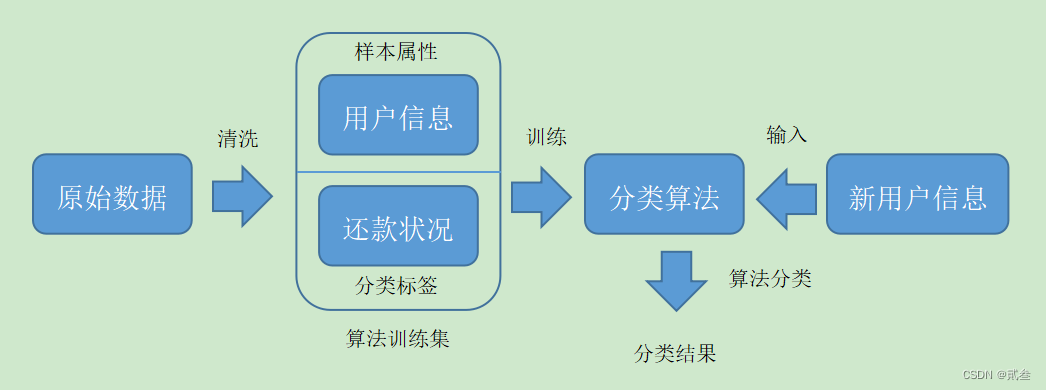
第一步:清洗原始业务数据,得到满足要求的训练数据集;
第二步:选用合适的数据挖掘分类算法进行模型训练(还可以对算法参数进行调优);
第三步:在模型中输入新用户信息即可得到预测结果。
二、数据处理
本案例数据文件来自于一家网络贷款公司,本文仅选择部分数据进行使用,原数据下载地址:https://www.kaggle.com/husainsb/lendingclub-issued-loans
# 读取数据
dforigin = pd.read_csv('LendingClub10k.csv',sep=',')
dforigin.info()
print(dforigin.shape)

2.1 选取数据
观察分类标签字段loan_status:
# 显示 loan_status字段
dforigin['loan_status'].value_counts()
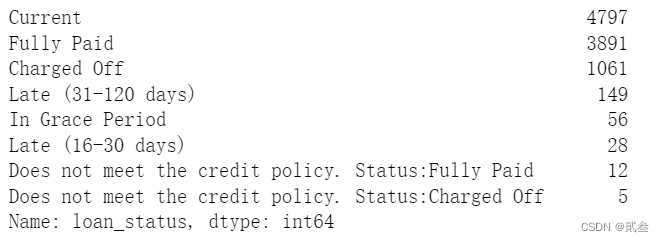
发现除了正常还款、违约之外还有其他分类,由于本文只分析此两类情况,所以接下来直接选取包含这两个标签的数据:
# 显示 loan_status 是 Fully_paid 和 Charged off取值的记录数
df = dforigin.loc[dforigin['loan_status'].isin(['Fully Paid', 'Charged Off'])].copy(deep=True)
print(df['loan_status'].value_counts())
print(df.shape)

观察违约比例:
# 显示df中正常还款和违约样本比例
print(df['loan_status'].value_counts() / df.shape[0])

并将标签数据化:
# Fully paid 取值为0; Charged off 取值为 1
df['loan_status'] = df['loan_status'].apply(lambda s: np.float(s == 'Charged Off'))
print(df['loan_status'].value_counts())
df.rename(columns={'loan_status':'charged_off'}, inplace=True)

2.2 删除无效数据
对于某些列都是相同的值,其对数据挖掘提供不了有效信息,因此可将其删除:
# 丢弃只有唯一值的列
drop_list = []
for col in df.columns:
if df[col].nunique() == 1:
drop_list.append(col)
print(drop_list)
print(df.shape)
df.drop(labels=drop_list, axis=1, inplace=True)
print(df.shape)

而有些列存在大量缺失数据,严重影响数据分析,也将其舍去:
# 丢弃那些大量缺失值的列
drop_list = []
for col in df.columns:
if df[col].notnull().sum() / df.shape[0] < 0.02:
drop_list.append(col)
print(drop_list)
df.drop(labels=drop_list, axis=1, inplace=True)
print(df.shape)

最后,根据字段的具体意义及个人主观看法,将明显与目标字段(分类标签)无关的数据进行删除:
# 丢弃那些明显与目标无关的列
df.drop(labels=['id', 'emp_title', 'title', 'last_credit_pull_d',
'earliest_cr_line'], axis=1, inplace=True)
df.drop(labels=['collection_recovery_fee', 'debt_settlement_flag',
'last_pymnt_amnt', 'last_pymnt_d', 'recoveries',
'total_pymnt', 'total_pymnt_inv', 'total_rec_int',
'total_rec_late_fee', 'total_rec_prncp'], axis=1, inplace=True)
df.shape
2.3 分析属性关系
# 考察贷款目的与违约之间的关系
plt.figure(figsize=(12,8))
sns.countplot(y='purpose', hue='charged_off', data=df,
orient='h',palette = 'BuPu')
plt.yticks(size=18)
plt.ylabel('贷款目的',fontdict={'size':18})
plt.xticks(size=18)
plt.xlabel('业务数量',fontdict={'size':18})
# plt.savefig("ch18_lc01.jpg",dpi=300,bbox_inches="tight")
plt.show()
从图中可以看出,网络借贷的目的大多是为了债务转移和信用卡还贷,同时其违约率也较高,可反映出这样的一个事实:借款人是由于背负贷款被银行等传统机构排除在外,只能通过网络借贷来偿还其贷款。
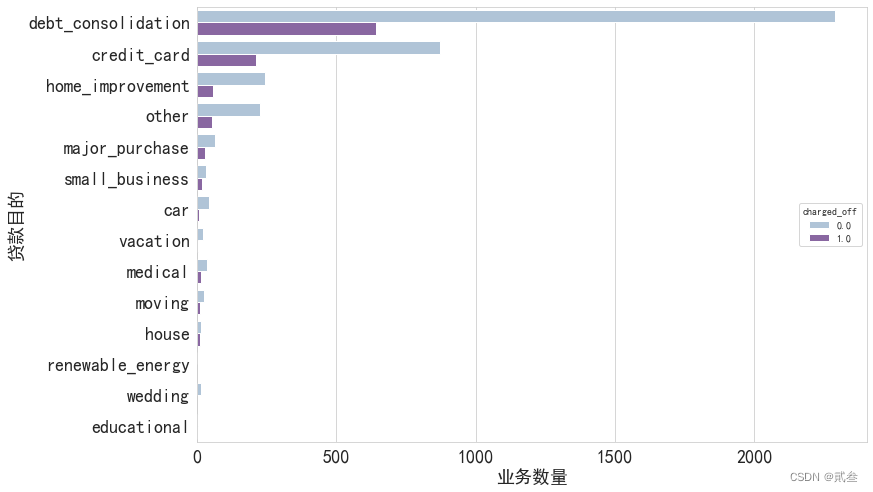
# 考察信用分级与违约之间的关系
plt.figure(figsize=(12,8))
sns.countplot(y='sub_grade', hue='charged_off', data=df,
order=sorted(df['sub_grade'].value_counts().index),
orient='h',palette = 'BuPu')
plt.ylabel('客户分级',fontdict={'size':18})
plt.xticks(size=18)
plt.xlabel('业务数量',fontdict={'size':18})
# plt.savefig("ch18_lc02.jpg",dpi=300,bbox_inches="tight")
plt.show()
从图中可以看出,客户评级越低,其中违约的人数所占比例越多,甚至存在所处等级的借款人都出现违约的情况,可见等级越低越容易违约。
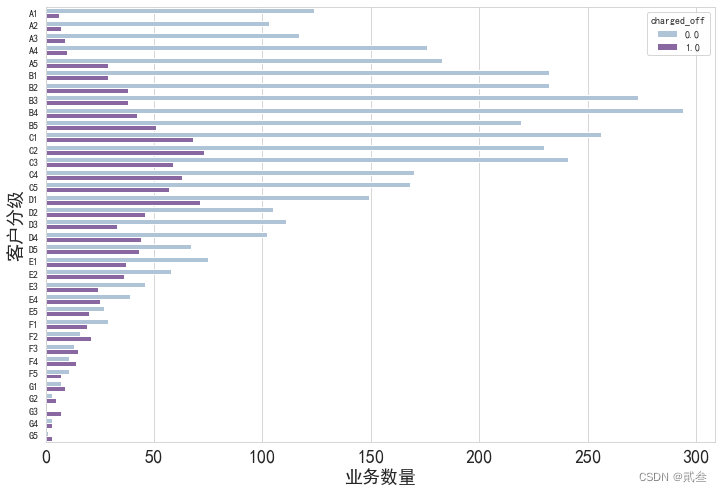
#考察贷款期限与违约之间的关系
plt.figure(figsize=(4,4))
sns.countplot(x='term', hue='charged_off', data=df)
# plt.savefig("ch18_lc03.jpg",dpi=300,bbox_inches="tight")
plt.show()
然后是与借款期限的关系,从图中可以看出:60个月的贷款业务其违约率更高,可推断出长期贷款违约率高于短期贷款。
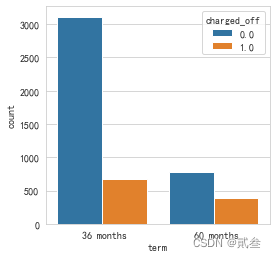
# 考察FICO评分与违约之间的关系
plt.figure(figsize=(12,6))
sns.kdeplot(df['last_fico_range_high'].loc[df['charged_off']==0],
gridsize=500, label='charged_off = 0',linewidth=2,linestyle='--')
sns.kdeplot(df['last_fico_range_high'].loc[df['charged_off']==1],
gridsize=500, label='charged_off = 1',linewidth=2,linestyle='-')
plt.xlabel('last_fico_range_high评分',fontdict={'size':18})
plt.ylabel('FICO评分概率密度分布',fontdict={'size':18})
# plt.savefig("ch18_lc04.jpg",dpi=300,bbox_inches="tight")
plt.show()
最后是FICO评分与违约的关系,从图中可以明显看出,违约客户的FICO评分均值远低于正常客户的FICO评分。
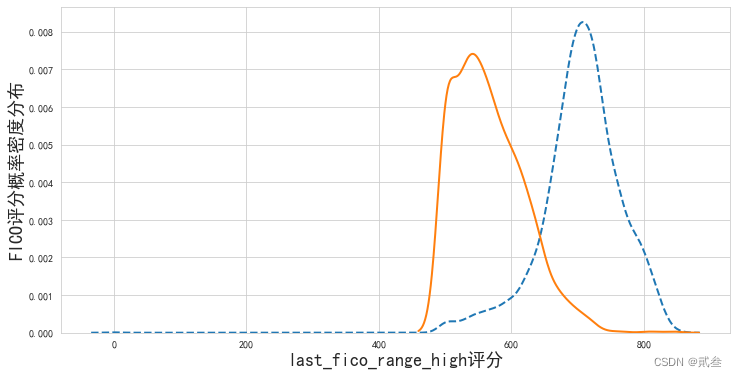
# 多属性相关性分析
corr_charged_off = df.corr()['charged_off']
corr_charged_off.drop(labels='charged_off', inplace=True)
corr_charged_off = corr_charged_off.sort_values()
plt.figure(figsize=(8,28))
sns.barplot(y=corr_charged_off.index, x=corr_charged_off.values, orient='h')
plt.title("Correlation with 'charged_off'")
plt.xlabel("Correlation coefficient with 'charged_off'")
xmax = np.abs(corr_charged_off).max()
plt.xlim([-xmax, xmax])
# plt.savefig("ch18_lc05.jpg",dpi=300,bbox_inches="tight")
plt.show()
最后,可以观察各属性与分类标签之间的关系,如FICO与违约存在极强的负相关性,即FICO分数越高,违约可能性就越低。
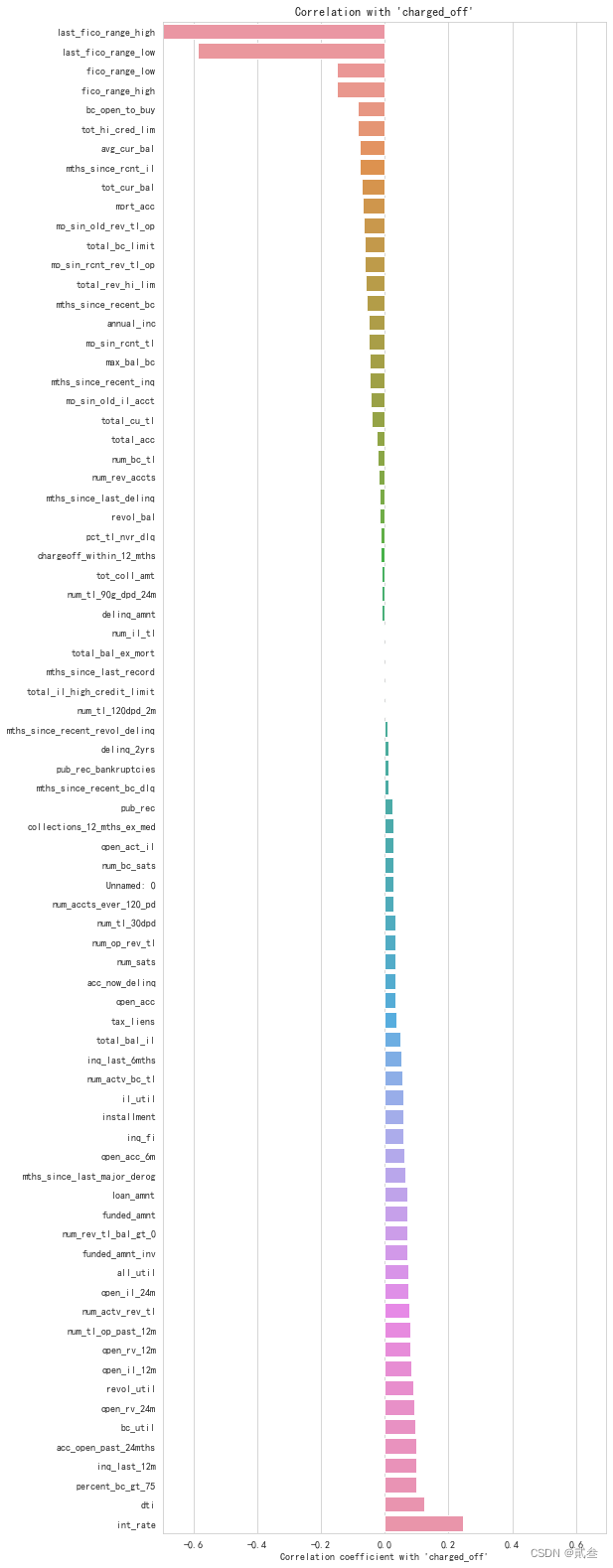
2.4 数据再处理
因为数据中还存在非数据值类型的,如要进行数据挖掘还需将其转化为数值:
# 非数值型数据转换为数值型
text_cols = []
for col in df.columns:
if df[col].dtype == np.object:
text_cols.append(col)
print(text_cols)

然后依次对各列数据进行数值转化:
# 转换term列
df['term'] = df['term'].apply(lambda s:np.float(s[1:3]))
# There's an extra space in the data for some reason
print(df['term'].value_counts())

#转换disbursement_method列
DisbMethod_dict = {'Cash':0.0, 'DirectPay':1.0}
def DisbMethod_dict_to_float(s):
return DisbMethod_dict[s]
df['disbursement_method'] = df['disbursement_method'].apply(lambda s: DisbMethod_dict_to_float(s))
print(df['disbursement_method'].value_counts())

最后将不重要的数据在此删除,最终得到数据大小为:(4952, 89)
#Some comments in this column, impossible to convert to numeric
df.drop(labels=['desc'], axis=1, inplace=True)
df.drop(labels=['issue_d'], axis=1, inplace=True)
df.shape
三、模型训练
在将数据清洗完成之后,就可以进入下一步的模型训练了
3.1 分离训练集
首先,先将数据的分类标签和各属性分离开来:
X = df.drop(labels=['charged_off'], axis=1) # Features
y = df['charged_off'] # Target variable
然后,分离训练集和测试集:
from sklearn.model_selection import train_test_split
random_state = 12 # I chose this randomly, just to make the results fixed
X_train, X_test, y_train, y_test = train_test_split(X, y, test_size=0.1, random_state=random_state)
pd.DataFrame((X_train.notnull().sum() / X_train.shape[0]).sort_values(), columns=['Fraction not null'])
最后,将这四个数据集进行统一的标准化处理:
imputer =SimpleImputer(missing_values=NA, strategy = "mean").fit(X_train)
X_train = pd.DataFrame(imputer.transform(X_train), columns=X_train.columns)
X_test = pd.DataFrame(imputer.transform(X_test), columns=X_test.columns)
from sklearn.preprocessing import StandardScaler
scaler = StandardScaler().fit(X_train)
X_train = pd.DataFrame(scaler.transform(X_train), columns=X_train.columns)
X_test = pd.DataFrame(scaler.transform(X_test), columns=X_test.columns)
可以得到:
print("df.shape:",df.shape)
print("X_train:",X_train.shape)
print("y_train:",y_train.shape)
print("X_test:",X_test.shape)
print("y_test:",y_test.shape)
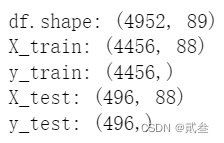
3.2 模型训练
接下来进行数据挖掘模型训练,需要说明的是:由于受到随机抽样和算法数学特性等因素的影响,每次运行结果都可能存在细微的差异。
第一个训练的模型是逻辑回归模型:
#逻辑回归模型
from sklearn.linear_model import LogisticRegression
lrmodel=LogisticRegression(solver='liblinear') #初始化
start=datetime.datetime.now()
lrmodel.fit(X_train,y_train) #fit训练模型参数
end=datetime.datetime.now()
y_lrpred=lrmodel.predict(X_test)
my_eval(y_test, y_lrpred)
print('Runtime =',end-start)
可以看到准确率达到91%,AUC=0.85,运行时间也比较低。
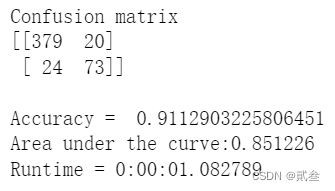
其次,是随机森林模型训练:
# 随机森林模型
from sklearn.ensemble import RandomForestClassifier
rfmodel=RandomForestClassifier()
start=datetime.datetime.now()
rfmodel.fit(X_train, y_train)
end=datetime.datetime.now()
y__rfpred=rfmodel.predict(X_test)
my_eval(y_test, y__rfpred)
print('Runtime =',end-start)
可以看到准确率也很高,AUC值比逻辑回归模型更高,但花费的时间要多一些。
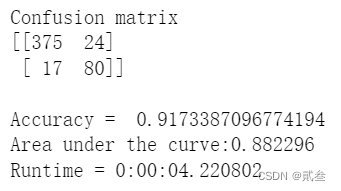
最后是SGDClassifier模型,它是一系列采用了梯度下降来求解参数的算法的集合,如SVM、logistic、regression等,其相关参数的设置可自行上网搜索:
# SGDClassifier模型
from sklearn.linear_model import SGDClassifier
from sklearn.model_selection import GridSearchCV
from sklearn.metrics import matthews_corrcoef, make_scorer
from sklearn.metrics import roc_auc_score
param_grid = [{'loss': ['hinge'],
'alpha': [10.0**k for k in range(-3,4)],
'max_iter': [1000],
'tol': [1e-3],
'random_state': [random_state],
'class_weight': [None, 'balanced'],
'warm_start': [True]},
{'loss': ['log'],
'penalty': ['l2', 'l1'],
'alpha': [10.0**k for k in range(-3,4)],
'max_iter': [1000],
'tol': [1e-3],
'random_state': [random_state],
'warm_start': [True]}]
grid = GridSearchCV(estimator=SGDClassifier(), param_grid=param_grid, scoring=make_scorer(matthews_corrcoef),
n_jobs=1, pre_dispatch=1, verbose=1, return_train_score=True)
start=datetime.datetime.now()
grid.fit(X_train, y_train)
end=datetime.datetime.now()
y_SGDCpred = grid.predict(X_test)
my_eval(y_test,y_SGDCpred)
print('Runtime =',end-start)
最终,我们可以看到其AUC有了较大地提升,只是花费了更多的时间来进行训练。

四、模型预测
最后,我们可以在测试集中随机选取一条用户数据,利用训练好的三个模型对其进行预测,结果可以看到:三个模型预测的结果都正确。
#使用训练好的三种模型进行预测
#从x_test中抽取一条记录,作为模拟的新输入数据
new_input=X_test.iloc[10].values.reshape(1,-1)
print("new_input=",new_input)
new_output=y_test.iloc[10]
print("new_output=",new_output)
#使用=逻辑回归模型对该数据进行预测
print("逻辑回归预测prediction=",lrmodel.predict(new_input))
#使用随机森林模型对该数据进行预测
print("随机森林预测 prediction=",rfmodel.predict(new_input))
#使用SGDClassifier模型对该数据进行预测
print("SGDC模型预测 prediction=",grid.predict(new_input))
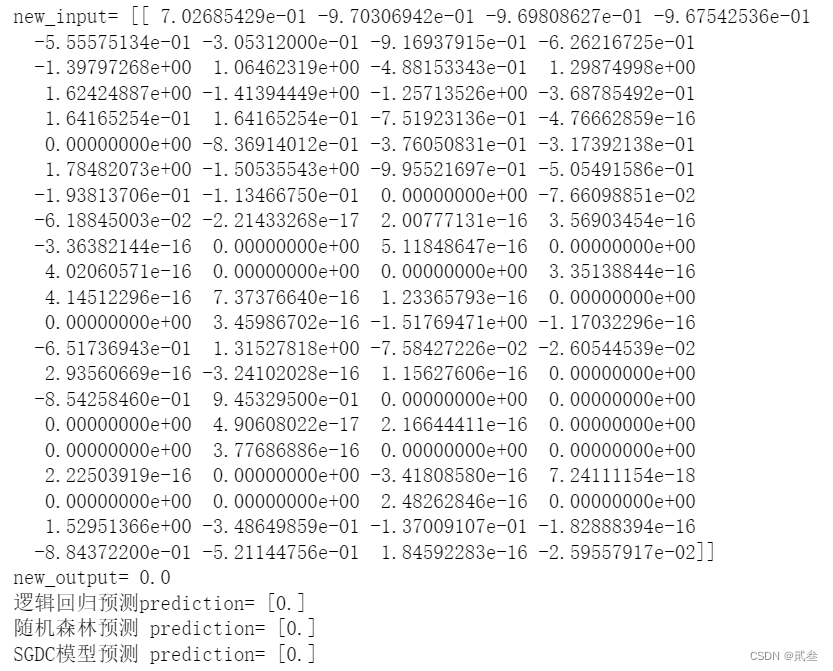
最后的最后,大家如果觉得文章不错的话,记得点赞、收藏、关注三连~
我会把相关数据和完整代码整理好上传到我的资源,大家也可以下载下来自己研究
除此之外,还有以前写的【综合案例】信用卡虚拟交易识别;以及接下来将要写的【综合案例】信用评分模型开发,大家可以关注一下哦~